|
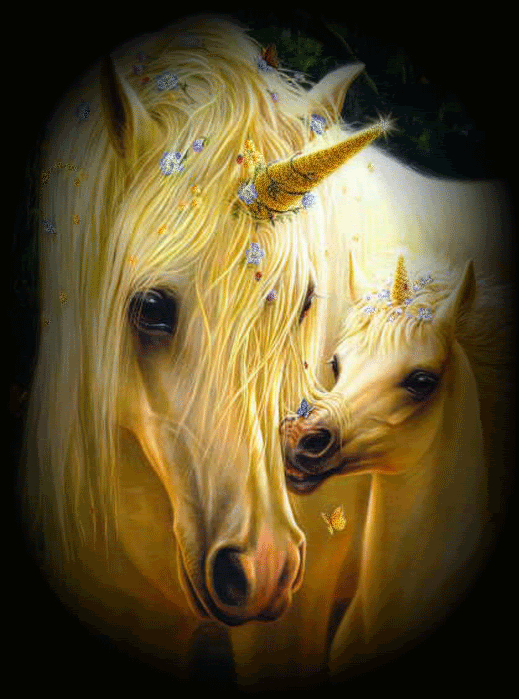
art by Sue Dawe:
http://home.simplyweb.net/suedawe/
"When God created the earth, He made a river which flowed from the Garden of Eden... Then God told Adam to name the animals... And the first animal he named was the unicorn. When the Lord heard the name Adam had spoken, he reached down and touched the tip of the single horn growing from the animal's forehead. From that moment on, the unicorn was elevated above other beasts."
~ Nancy Hathaway ~
  
The unicorn is a legendary creature like a horse, but with a slender, usually spiral, horn growing out of its forehead. The popular image of the unicorn is that of a white horse differing only in the horn.
In mideval lore, the spiraled horn of the unicorns was called the alicorn, and was thought to neutralize poisons. In popular mythology, unicorns were hunted for their horns, which were said to protect one against diseases, or, if made into a cup, would protect one from any poison that might have been added to one's drink. This belief is derived from Ctesias' reports on the unicorn in India, where it was used by the rulers of that place for anti-toxin purposes so as to avoid assassination.
People sold what they purported to be unicorn horns at this time, but were actually selling narwall horns (narwalls are whales with large, horn-like tusks that swim in cold water.)
Traditionally, the unicorn had a billy-goat beard, a lion's tail, and choven hoofs. Ironically, this perception was more realistic, as only cloven-hoofed animals have horns. Unicorns were once thought of as nasty, easily provoked creatures, unlike the gentle perception we have of them today. They were thought to have deep, bellowing voices. As Ctesias, the ancient Greek physician, said:
"The unicorn was native to India, the size of a donkey, with a burgundy head and white body; it had blue eyes, a single horn that was bright red at the top, black in the middle, and white at the bottom; the horn was also eighteen inches long."
Julis Ceasar also described the unicorn, saying, "It had a deer's head, elephant's feet, a three-foot long horn, and a boar's tail." It was not until the middle ages that the unicorn began to take on its present form.
A widespread legend is that, when Noah gathered two of every kind of animal, he neglected to gather the unicorns, which is why they do not exist today.
The quilin, a creature in Chinese myth, is sometimes called "the Chinese unicorn," but is not directly related to the Western unicorn. The quilin has the body of a deer, the lead of a lion, green scales and a long froth-covered horn. In Japanese, the word kirin (written with the same Chinese ideograms) is used to designate both the giraffe and the mythical creature. Although the Japanese kirin is based on Chinese myth, it more closely resembles the Western Unicorn than does the Chinese quilin.
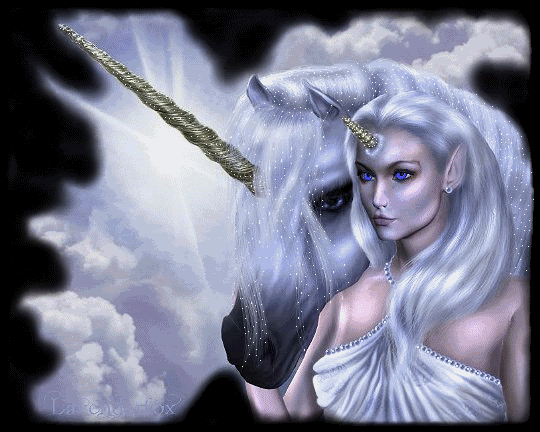
original art by Amanda Walsh
Unicorns in Ancient History
In the West
An animal called the re'em is mentioned in several places in the Bible, often as a metaphor representing strength. In the King James Version, as well as some other translations, the word is translated as "unicorn," producing such phrases as "His strength is as the strength of a unicorn." These references allude to the re'em as a wild, untamable animal of great strength and agility, with mighty horns. These references may have been referring to the aurochs (Bos primigenius). This view is supported by the Assyrian rimu, which is also used as a metaphor of strength, and is depicted as a powerful, fierce, wild, or mountain bull with large horns. This animal was often depicted with only one horn visible in ancient Mesopotamian art.
Ancient Greek writers were convinced of the reality of the unicorn. The earliest description is from Ctesias, who described "wild asses, fleet of foot, having on the forhead a horn a cubit and a half in length, colored white, red and black; from th ehorn were made drinking cups which were a preventive of poisoning." Aristotle also mentioned two one-horned animals: the oryx, a kind of antelope; and the so-called "Indian ass."
In Roman times, Pliny the Elder's Natural History mentions the oryx and an Indian ox (which may have referred to the rhinoceros) as one-horned beasts. He called the Indian ass "a very ferocious beast, similar in the rest of its body to a horse, with the head of a deer, the feet of an elephant, the tail of a boar, a deep, bellowing voice, and a signle black horn, two cubits in length, standing out in the middle of its forehead." Pliny added that "it cannot be taken alive." Aelian, quoting Ctesias, added that India produces also a one-horned horse, and said that the "monoceros" was sometimes called "carcazonon," which may be a form of the Arabic "carcadn," meaning "rhinoceros." Strabo said that in India there were one-horned horses with stag-like heads.
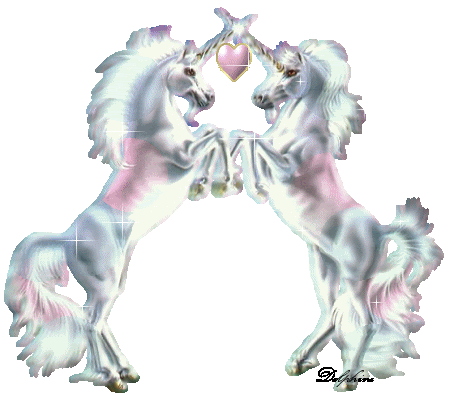
Unicorns in the Middle Ages
Mideval knowledge of the unicorn stemmed from biblical and ancient sources. The creature was variously represented as a kind of wild ass, goat, or horse. By 200 A.D., Tertullian had called the unicorn a small fierce kidlike animal, a symbol of Christ. Ambrose, Jerome, and Basil agreed. Physiologus, a predecessor to the medieval bestiary, popularized an elaborate allegory in which a unicorn, trapped by a maiden representing the Virgin Mary, stood for the Incarnation. As soon as the unicorn saw her, it lay its head on her lap and fell asleep. This became a basic emblematic tag that underlies medieval notions of the unicorn, justifying its appearance in every form of religious art.
With the rise of humanism, the unicorn also acquired positive secular meanings, including chaste love and faithful marriage.
Marco Polo described the unicorn as tamable only by maidens:
"Scarcely smaller than elephants. They have the hair of a buffalo and feet like an elephant's. They have a single large black horn in the middle of the forehead. They have a head like a wild boar's. They spend their time by preference wallowing in mud and slime. They are very ugly brutes to look at. They are not at all such as we describe them when we relate that they let themselves be captured by virgins, but clean contrary to our notions."
It is clear that Polo was describing a rhinoceros.
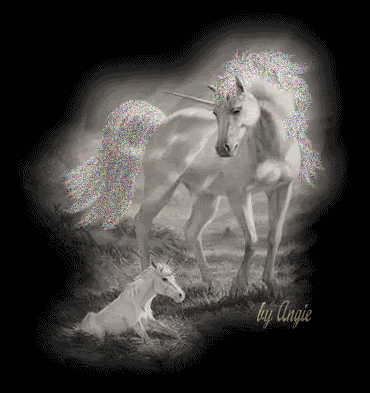
The famous late Gothic series of seven tapestry hangings, The Hunt of the Unicorn, combined both secular and religious themes. In the series, richly dressed noblemen, accompanied by huntsmen and hounds, pursue a unicorn against millefleurs backgrounds or buildings and gardens. They bring the animal to bay with the help of a maiden who traps it with her charms, appear to kill it, and bring it back to a castle. In the last and most famous panel, The Unicorn in Captivity, the unicorn is shown bloody but now alive and happy, chained to a tree surrounded by a fence, in a field of flowers. Scholars continue to hunt the meaning of the resurrected Unicorn.
A set of six called the Dame a la licorne (The Lady of the Unicorn) at the Musee de Cluny, Paris, woven in the Southern Netherlands about the same time as The Unicorn in Captivity, pictures the five senses, the gateways to temptation, and finally Love, with unicorns in each hanging.
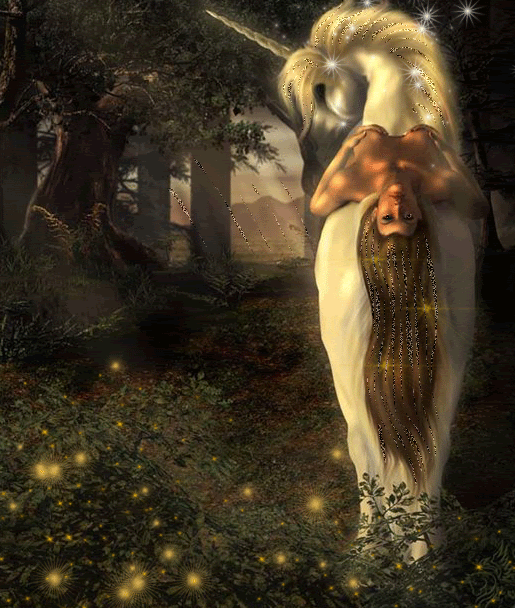
East and West
The Eastern Unicorn
The unicorn of Eastern tradition is very different in appearance from the Western unicorn, but they share many characteristics. For example, the Eastern unicorn was depicted as a solitary animal, believed to have sprung from the center of the earth, the first and most perfect of the 360 land creatures. The Eastern unicorn always reached its destination, never falling into pits or traps, so it was honored as a great spiritual guide through life. The unicorn's gentleness prevented it from treading upon an insect or eating fruit. It was said to be so sensitive it could feel the weight of a shadow cast by the light of the moon.
All animals became tame around the unicorn. Rain and fire did its bidding, and when it plucked a leaf, two grew in its place. The unicorn's voice was sweet and delicate, with the sound of a thousand wind chimes. In the East they believed that once a unicorn was tamed, no other animal would ever know terror again. And, as long as humans showed greed, anger, and war, and hunger was around, the unicorn would remain elusive, hidden and wild. During evil times it would appear only when a great change was about to occur. In many Eastern cultures, the unicorn is occasionally linked with the tiger and the lioness. Although these relationships are not always considered compatible in Western lore, it is very different in the East. The tiger is a fierce creature in Eastern tradition, its ferocity and courage often unmatched. The tiger is considered a yang (male) creature, as opposed to the yin (female) unicorn and will fight earthly demons which encourage humans to kill the unicorn. Lions and lionesses are very similar, fighting for wisdom and truth and scaring away demons with teeth and claws.
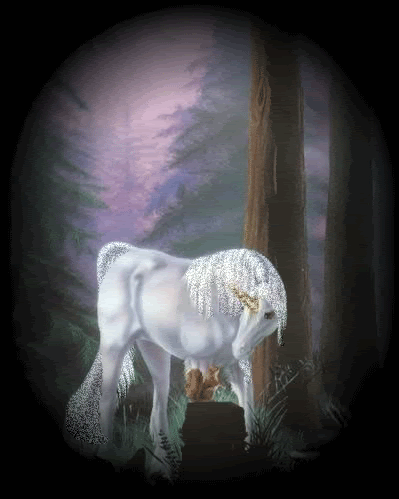
art by Sue Dawe:
http://home.simplyweb.net/suedawe/
Other Eastern Unicorns
Japan's version of the unicorn, the Kirin or Sin-you was depicted with sinews more like those of a lion. Although the Kirin was normally a shy creature, taking large detours to avoid confrontations, the Sin-you unicorn was not so timid. It was known for its ability to know right from wrong and was often called upon to determine the guilt or innocence of individuals. If an individual was determined to be guilty, the Sin-you would fix its eyes upon him and pierce the guilty person with its horn.
In Taoism and other mystical Eastern cultures, there arose a variety of teachings in art and dance to honor all of nature, including the unicorn and other sacred beasts. In Vietnam, a yearly unicorn dance is held on the full moon of the eighth month, the beginning of the monsoon season. People put on masks and costumes to conceal their identity. When their spirits are high, they tie an effigy of a unicorn to a platform. Archers then shoot at it while singing the effigy song .After the song is finished, the rains would begin.
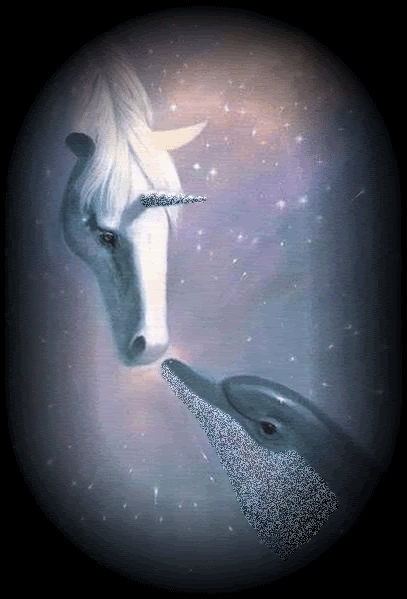
art by Sue Dawe:
http://home.simplyweb.net/suedawe/
The Middle Eastern Unicorn
In Persia and Arabia, the unicorn was called Karkadann, a beast so ferocious it could attack and kill an elephant. It was a violent, warlike unicorn, born in blood and vehement in battle. It had the body of a rhino and a tail like a lion. Each leg had three hooves, one in front and two in back. From its forehead rose a single black horn, curved like a crescent. Unlike the western unicorn, it was dreaded by all living creatures and left alone. The Karkadann could only be tamed by a ring dove. It is said this beast responded so strongly to the dove's gentle call that it would lie beneath a dove's tree for hours and wait for the dove to land on its horn. In other descriptions in Middle Eastern unicorn lore, the Karkadann was a fierce animal with magical abilities. It resembled a stag, horse or antelope, and the elephant was its deadly enemy. It could be mild and tender hearted though, drinking the morning dew from green plants. And when it put its head in water, the water would become pure and fruitful, opposites would unite, and all female creatures in the water would become pregnant. Any evil within the water would die and be cast out upon the shore.
As in western unicorn lore, the Karkadann was extremely fond of women, who were used as lures to capture the beast. However, in the eastern tradition, the women did not have to be virgins. Capture of this unicorn was much rarer than in western tradition. This was likely the result of the difficulty in finding women willing to cooperate in capturing such a ferocious beast. The elephant was the deadly enemy of the Karkadann, and there are many tales about their great battles. In the most famous, the Karkadann stabs the elephant in the belly with his horn. Unable to dislodge his horn, the elephant collapses upon the Karkadann. A Roc, a giant mythical bird in Persia, flies by at this moment, diving and grabbing both beasts and lifting them up into the sky. The Roc then flies to its nest and feeds both the Karkadann and the elephant to its young. Allegedly only one human every tamed the Karkadann ........Alexander the Great.
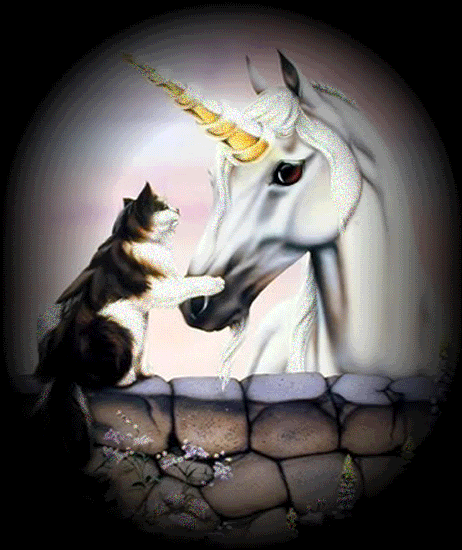
art by Sue Dawe:
http://home.simplyweb.net/suedawe/
The Western Unicorn
The Western Unicorn is the typical unicorn most of us are familiar with.
The German Unicorn
German-speaking peoples have long been strong believers in unicorns. During the Middle Ages their churches and palaces were filled with images of the creature, known to them as Einhorn. In German Marian mysticism (the cult of the adoration of the Virgin), the name given to the mother of God was Maria unicornis (Mary of the unicorn).
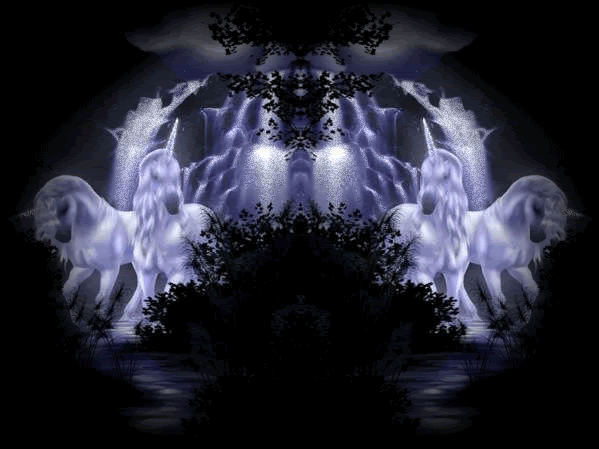
art by Amanda Walsh
The Wise Woman Of Scharzfeld
The Harz Mountains region of central Germany has long been considered a haunt of the Einhorn. In fact, there is a cave in this area which to this day is called the Einhornhohle. It acquired its name from a story which took place in the days when much of Germany was covered with dark, unmapped forests, which were ruled by the old gods. In this forest an old wise woman lived in the Steingrotte Cave near Scharzfeld. People came to her from all over the Harz region for healing and advice. This angered the Christian missionaries in the area and they denounced her as a witch. The missionaries used their influence with a Frankish king, whom they had converted, to send soldiers and a monk to arrest her. As the soldiers were making their way up the steep hill to her cave, the old woman came out and looked down upon them with total disdain and lack of fear. At first the soldiers hesitated, but realizing she was only one old woman, they continued climbing up to the cave. Then a pale Unicorn stepped out of the forest, its horn shining against the gloom cast by the trees. It went up to the woman and knelt before her, she got up on its back and rode away.
The monk and soldiers ran after her, but soon fell behind because of their heavy armor and weapons. The monk was finally able to catch up with the woman, but as he tried to grab her, she raised her arms and made signs in the air¡ªand the monk disappeared. By the time the soldiers reached the spot, all they found was a hole in the ground with the monk lying shattered and lifeless at the bottom. The soldiers buried the monk and named the cave Einhornhohle, a name by which it has been known ever since.
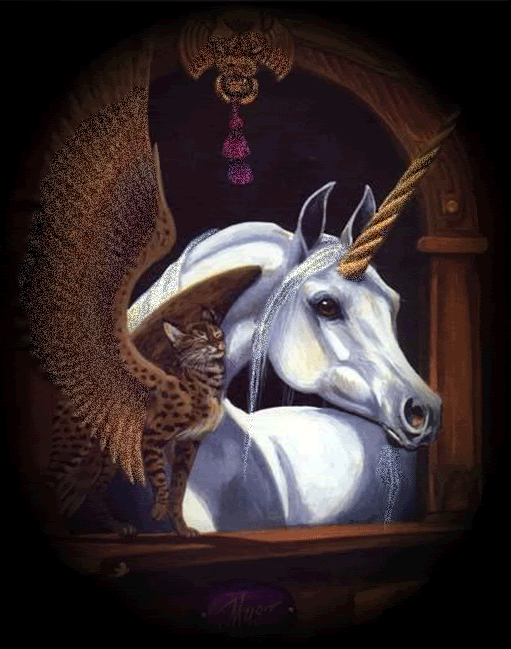
art by Sue Dawe:
http://home.simplyweb.net/suedawe/
This day and age there is no more likely a place to find a unicorn than in the ancient Hercynian Forest. The forest is dominated by the Brocken Mountain, which in the Middle Ages was associated with witches' sabbats, usually the sign of an earlier link with cults of the Moon Goddess, whose creature was the unicorn.
This region of Germany straddles the old border between East and West Germany. For over forty years after World War II, a large section of it was fenced off as a no-man's land and left entirely to its own devices. It is one of the last true wildernesses left in Europe, a slice of the ancient, dark enchanted woods of German folklore and legend. Could this be the last refuge of the unicorn in the modern world? Is it possible some of the magic of the old gods who were said to rule the forests remains, protecting the unicorn from discovery?
I certainly don't have the answers to these questions. But, I do know that there are many areas of our modern world which still remain virtually unexplored. Who knows what wonders we might still find in the years ahead! The unicorn is a marvelous, mystical creature full of hope and possibilities. Belief in the unicorn helps us remember to ask the question, "Why not?"
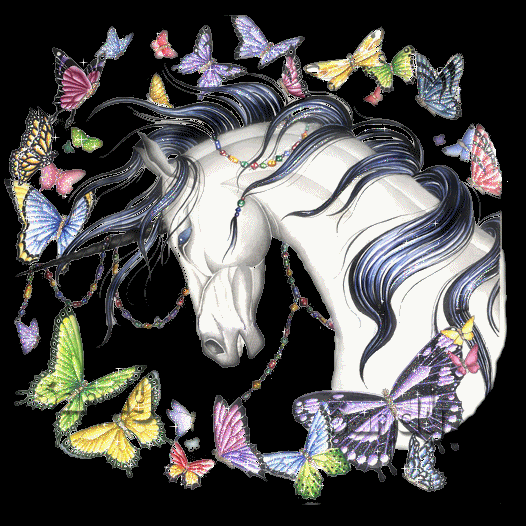
information by:
http://www.unicornlady.net/
http://www.crystalinks.com/
  
background and graphics by:
  





|